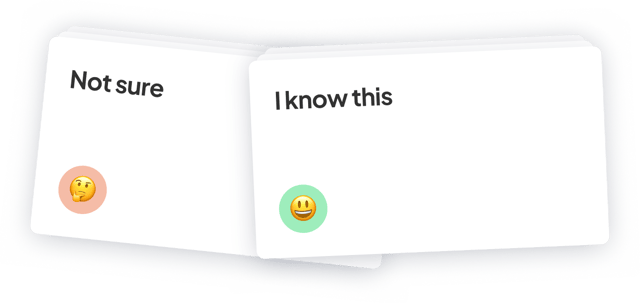Probability Diagrams: Venn & Tree Diagrams (Edexcel IGCSE Maths A (Modular)) Flashcards
Exam code: 4XMAF/4XMAH
1/12
0Still learning
Know0
Describe how to find
from a Venn diagram that shows sets
and
.
E.g. find
from the Venn diagram.

is the probability of being in set
.
This is the number inside the full circle of set
divided by the total number of the whole Venn diagram, e.g.
.


Sign up to unlock flashcards
Join for free to unlock a full flashcard set, track what you know,
and turn revision into real progress.Describe how to find
from a Venn diagram that shows sets
and
.
E.g. find
from the Venn diagram.

is the probability of being in the intersection of set
and set
.
This is the value inside the overlapping region of set
and set
divided by the total number of the whole Venn diagram, e.g.
.

True or False?
If
and
are mutually exclusive, then
.
True.
If
and
are mutually exclusive, then
.
On a Venn diagram, if
and
are mutually exclusive then their circles do not overlap (they cannot both happen at the same time).
This makes being in the intersection impossible, so
.
Did this page help you?
Cards in this collection (12)
Describe how to find
from a Venn diagram that shows sets
and
.
E.g. find
from the Venn diagram.

is the probability of being in set
.
This is the number inside the full circle of set
divided by the total number of the whole Venn diagram, e.g.
.

Describe how to find
from a Venn diagram that shows sets
and
.
E.g. find
from the Venn diagram.

is the probability of being in the intersection of set
and set
.
This is the value inside the overlapping region of set
and set
divided by the total number of the whole Venn diagram, e.g.
.

True or False?
If
and
are mutually exclusive, then
.
True.
If
and
are mutually exclusive, then
.
On a Venn diagram, if
and
are mutually exclusive then their circles do not overlap (they cannot both happen at the same time).
This makes being in the intersection impossible, so
.
True or False?
To find
you need to double-count the numbers in the intersection (overlap) as they occur twice.
False.
To find
you do not double-count the numbers in the intersection
, you just count them once.
Describe which region on a Venn diagram is required to calculate
.
E.g. find
from the Venn diagram.

The region required to calculate
is the one that is the overlap of all three sets
,
and
. E.g.
.

True or False?
On a Venn diagram showing sets
and
, the region required to calculate
is the part of set
that does not overlap
.
False.
On a Venn diagram showing sets
and
, the region required to calculate
is anything that is outside the circle of
, e.g.

On a Venn diagram showing sets
and
, explain how to calculate
.
E.g. find
from the Venn diagram.

is a conditional probability meaning the probability of being in
, given that you are in
. Therefore the probability is out of set
only.
The only part of set
in set
is
, so divide the number in
by the total number in
, e.g.
.

True or False?
To find the probability of A and B using a probability tree diagram, you add the probabilities on the branches for A and B.
False.
To find the probability of A and B using a probability tree diagram, you do not add the probabilities on the branches for A and B.
To find the probability of A and B, you multiply along the branches.
True or False?
The probabilities on all of the branches in a probability tree diagram should add up to 1.
False.
The probabilities on all of the branches in a probability tree diagram should not add up to 1.
The probabilities on any set of branches (usually a pair) should add up to 1.
True or False?
The sum of the probabilities of all of the final outcomes on a probability tree diagram should be equal to 1.
True.
The sum of the probabilities of all of the final outcomes on a probability tree diagram should be equal to 1.
A tree diagram is used to represent two events, A and B, where each event has three possible outcomes, 1, 2 and 3.
How many possible final outcomes are there?
For a tree diagram used to represent two events, where each events has three possible outcomes, there are nine possible final outcomes (32 = 9).

A tree diagram is used to represent three tennis matches, where each event has two possible outcomes: player A winning or player B winning.
How many possible final outcomes are there?
A tree diagram is used to represent three tennis matches, where each event has two possible outcomes: player A winning or player B winning.
There are eight possible final outcomes (23 = 8).
The eight outcomes are AAA, AAB, ABA, ABB, BAA, BAB, BBA, BBB.

Sign up to unlock flashcards
or
By signing up you agree to our Terms and Privacy Policy